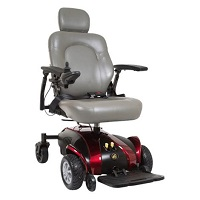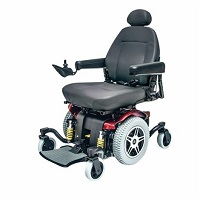Get 10% Off*, Use Code: HPDS25
Get 10% Off*, Use Code: HPDS25

Just as people come in a multitude of flavors, so do wheelchairs (especially power wheelchairs). Yes, they all do the same primary task of transporting the user from point A to point B, but there can be drastically different characteristics of each. In order to make the proper decision in choosing a wheelchair that is right for you and your lifestyle, you need to know what the specific differences of each type of wheel drive and configuration. We here at HPFY can give you the rundown on your options to help you choose.
Understanding your wheelchair (power or manual) is quite important since it will be your prime mode of mobility. By knowing the ins and outs of your chair, you can potentially avoid breakdowns or expensive service calls. Regardless of what power wheelchair you may own, there are some common parts to the drive system that each chair shares. These parts include, but are not limited to:

Power wheelchairs are not all created equal. There are different specifications and styles to each one. Knowing and understanding the differences in the setup of the wheel drive of your power wheelchair will go a long way in helping you make the correct decision. There are three main types of power wheelchair drives, and they are:
In this configuration, the drive wheels are located towards the front of the seat. Obviously, with the drive wheels up front the casters are located in the rear. Front-wheel-drive power wheelchairs usually can handle a curbing of 2 inches. They can be a stable ride whether traversing uphill or downhill when the batteries are located towards the rear to counterbalance any weight that is forward due to the electric motors. The turning radius of a front-wheel-drive wheelchair can be slightly larger and susceptible to fishtailing.
These have the electric motors and drive wheels located under the seat and is often referred to as a center drive chair. Of the three different types of drives, this set up has probably the tightest turning radius, which can be a selling point for those who live in an apartment or any tight surroundings. One downside is that it may make traversing rough terrain slightly more difficult since it could possibly sink or lose traction over loose impediments. These type of chairs are usually transported with a handicapped accessible van and sometimes have a weight limit of 600 pounds.

This style of wheelchair drive has the casters upfront and the drive wheels located in the rear. While traveling at higher speeds, this type of drive allows for greater mobility, but it does have a larger turning radius. One other plus is that rear-wheel drive setups have directional stability which means it is less susceptible to over steering and tracks straighter naturally all while handling rougher, outdoor terrain.
By understanding the pros and cons of each type of drive system can help you determine what type of power wheelchair may be beneficial to your situation and lifestyle. Your physical therapist can measure you to assure that the chair is fitted to you and that any features on the chair are appropriate for your physical abilities and safety.
Disclaimer: All content found on our website, including images, videos, infographics and text were created solely for informational purposes. Our content should never be used for the purpose of diagnosis or treatment of any medical conditions. Content shared on our websites is not meant to be used as a substitute for advice from a certified medical professional. Reliance on the information provided on our website as a basis for patient treatment is solely at your own risk. We urge all our customers to always consult a physician or a certified medical professional before trying or using a new medical product.

Kevin Cleary has been a Health Products For You contributor for many years and has a degree in marketing. His health and wellness journey has a very personal meaning and has guided him in his content writing for HPFY.
In 2006, ...
How To Increase Iron Levels Quickly
It’s a question that must have puzzled you like many others. Iron is essential in hemoglobin production and its inadequate levels can negatively impact your health. Dive into this informative article to explore top iron-rich foods that can help you fight iron deficiency.
10 Best Coccyx Cushions for Tailbone Pain
If you're like most people, you spend about 8 to 10 hours sitting every day. However unhealthy, it is part of life for many, and can cause tailbone pain. Coccyx cushions can help alleviate this pain. Click to read more and find the perfect coccyx cushion for your tailbone pain.
5+ Best Adult Diapers for Fecal Incontinence
Dealing with fecal incontinence can be challenging, but you're not alone. Read this article and navigate through discreet and effective solutions that help you manage fecal incontinence and let you live life on your terms with confidence and comfort.
Top 5 Best Reviewed Nebulizers of 2024
Need an effective and affordable nebulizer? Look no further, in this article we offer 5 of our best reviewed nebulizers that are loved by our customers. Click to read more and find the perfect nebulizer for all your respiratory needs.
10 Best Penis Pumps For Erectile Dysfunction
For anyone dealing with erectile dysfunction, penis pumps serve as a great way to manage it. But with so many products available, determining the best one for your needs can be challenging. To assist you in refining your choices and making an informed decision, here are our top 10 options, recognized for their effectiveness and safety.